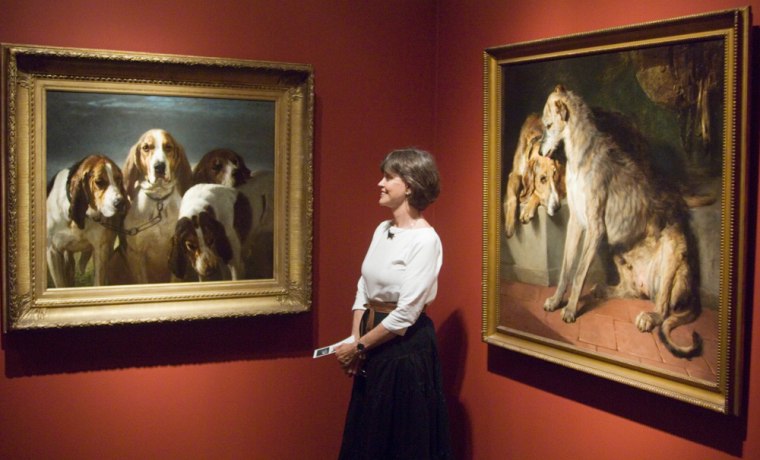GREENWICH, Conn. — They're furry, loyal and playful. They have the distinction of being man's best friend.
And now, dogs are the focus of an art exhibit in southern Connecticut.
With "Best in Show: Dogs in Art from the Renaissance to the Present," the Bruce Museum looks at how wet-nosed canines have commanded the attention of artists throughout Western art history, not just for their friendly personalities but for the human-like emotions they portray.
"When you start to look at art, you'll discover that dogs are everywhere in the 18th century," said art historian Robert Rosenblum, who helped curate the exhibit. "Dogs, unlike any other animal, have been so close to human beings throughout the ages that no other animal can really reflect human concerns, human emotions as fully as dogs can."
Dogs were included in the majority of family portraits in the 18th century, Rosenblum said.
Domesticated dogs are said to have descended from wolves, which were traced back some 37 million years ago in North America. And throughout history, dogs have played an integral part in society, revered in cultures around the world. In Egyptian mythology, the dog was so appreciated it was deified.
Famous artists' works
Some of the pieces at the Bruce Museum, on loan from museums and private collections in the U.S. and Europe, are produced by artists famous for their animal portraits, like 18th century British painter Sir Edwin Landseer and George Stubbs, known for his portrayal of horses. Other artists in the exhibit include pop art artist Andy Warhol, Flemish painter Frans Snyders, portrait and landscape artist Thomas Gainsborough and Italian artist Giovanni Battista Tiepolo.
Nearly 35 pieces of artwork are on display, from a Landseer painting showing a small, white terrier teasing a hedgehog in the grass to a larger-than-life, brightly painted portrait of a cocker spaniel by Warhol.
There are playful dogs, sleeping dogs, hounds on the hunt. There are dogs causing havoc and even a chocolate spaniel playing a piano. Some dogs dominate the landscape like George Stubbs' portrait of a curly-haired Norfolk water spaniel which stands dignified in front of a cloudy blue sky. Others elegantly lounge about on a poofy little cushion or Victorian couch.
Linda Seaver, 58, a family therapist from Bedford, N.Y., says she can't imagine life without dogs, having two Bernese mountain dogs at home. As she walked through the exhibit, her eyes gazed approvingly from one painting to another.
"What they capture is the personality of the dogs ... the sense of entitlement, the sense of play, the curiosity," Seaver said. "I've seen dog art exhibits before but the quality here could not be higher."
Her favorite was a 19th century Albert de Balleroy portrait of four French hounds with one staring directly at the viewer.
"I just think the soulfulness of the basset hound is just, it's perfectly captured," she said.
Emotion and devotion
One of the most emotionally provoking pieces of work, a Landseer painting that is said to be based on a true story, shows a small terrier gazing down at the body of its owner, who apparently had fallen from a cliff. The dog was guarding the man's body, which had been there for three months before a local found it, according to the exhibit catalog.
The painting epitomizes some of the characteristics that dogs are best known for _ devotion and selflessness.
Another painting, by 19th century artist John Sargent Noble, shows an encounter between a posh pug on his owner's townhouse doorstep and a scruffy terrier with a begging can hanging from his collar. The painting offers social commentary on the caste system of that period.
"It says something about the history of art and also the history of mankind," said Peter Sutton, executive director of the Bruce Museum.
The exhibit runs through Aug. 27 and will then travel to the Museum of Fine Arts in Houston. It coincides with an exhibit on the scientific evolution of dogs, "The Nature of Dogs," which runs until Nov. 26.
